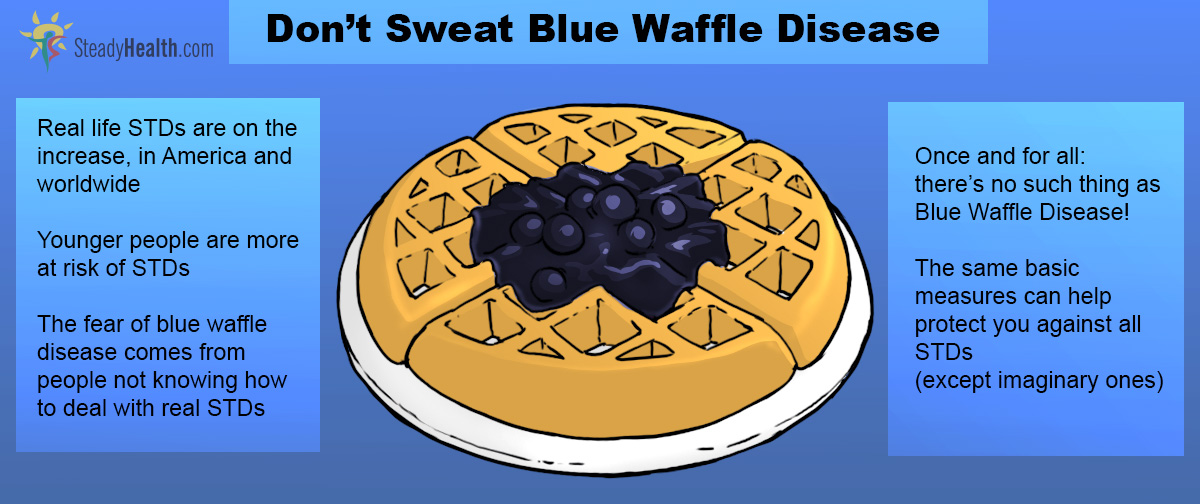Debunking The Blue Waffle Disease Hoax
Blue Waffle Disease: Understanding the Facts
Contrary to popular belief, "blue waffle disease" is not a real medical condition. The term is often associated with a hoax that originated online, involving fabricated images of a sexually transmitted infection (STI) characterized by blue or purple lesions on the genitals. These images are not representative of any actual STI and should not be taken seriously.
It is important to seek accurate information about STIs from reputable sources such as healthcare professionals or reliable medical websites. Self-diagnosing based on misleading online content can be dangerous and may lead to unnecessary anxiety or inappropriate treatment.
Remember, it is always best to consult a medical professional for proper diagnosis and treatment of any health concerns, including STIs.
Understanding "Blue Waffle Disease Picture"
The term "blue waffle disease picture" refers to a hoax that originated online, involving fabricated images of a sexually transmitted infection (STI) characterized by blue or purple lesions on the genitals. These images are not representative of any actual STI and should not be taken seriously.
- Misinformation: The blue waffle disease is a hoax and does not exist in reality.
- STI Awareness: It is important to seek accurate information about STIs from reputable sources.
- Image Manipulation: The images associated with the hoax are digitally altered and not.
- Cyberchondria: Misinformation online can lead to excessive health anxiety and self-diagnosis.
- Health Literacy: Understanding the difference between credible and unreliable health information is crucial.
- Media Influence: The spread of misinformation can be facilitated by social media and other online platforms.
- Medical Diagnosis: Consulting a healthcare professional is essential for proper diagnosis and treatment of health concerns.
- Sexual Health: Open and honest conversations about sexual health can help prevent the spread of misinformation.
- Digital Responsibility: Individuals should be mindful of the information they share and consume online.
In conclusion, the "blue waffle disease picture" hoax highlights the importance of seeking accurate health information from reliable sources, being critical of online content, and engaging in responsible digital behavior. Understanding the key aspects of this hoax can help individuals protect themselves from misinformation and make informed decisions about their health.
Misinformation
The misinformation surrounding the blue waffle disease picture is a prime example of how false information can spread rapidly online and have real-world consequences. The fabricated images associated with the hoax have caused unnecessary anxiety and fear among individuals who believe they may have contracted a non-existent STI.
The spread of misinformation about the blue waffle disease can also lead to people delaying or avoiding seeking proper medical care for actual STIs. This can have serious health implications, as early diagnosis and treatment of STIs is essential for preventing complications and onward transmission.
Understanding that the blue waffle disease is a hoax is crucial for preventing the spread of misinformation and protecting individuals from its harmful effects. It is important to be critical of health information found online and to only trust reputable sources, such as healthcare professionals and well-established medical organizations.
By raising awareness about the blue waffle disease hoax and promoting health literacy, we can help individuals make informed decisions about their health and prevent the spread of misinformation.
STI Awareness
The blue waffle disease picture hoax underscores the importance of STI awareness and seeking accurate information from reputable sources. Misinformation about STIs can lead to unnecessary anxiety, fear, and even delayed or avoided medical care.
- Understanding STI Symptoms: Accurate information about STI symptoms can help individuals recognize and seek treatment for actual infections, preventing complications and onward transmission.
- Prevention and Risk Reduction: Access to reliable STI information empowers individuals to make informed decisions about sexual health practices, reducing their risk of infection.
- Combating Stigma: Open and honest discussions about STIs, based on accurate information, can help reduce stigma and encourage individuals to seek testing and treatment without shame or embarrassment.
- Promoting Sexual Health: Comprehensive STI education and awareness campaigns can promote overall sexual health and well-being, leading to healthier sexual behaviors and reduced STI rates.
By emphasizing the importance of STI awareness and seeking accurate information, we can counter the spread of misinformation and empower individuals to take control of their sexual health. This is essential for reducing the burden of STIs and promoting the overall health and well-being of our communities.
Image Manipulation and the Blue Waffle Disease Picture
The blue waffle disease picture hoax heavily relies on digitally altered and fabricated images to create a false narrative about a non-existent STI. Image manipulation has become a concerning issue, as it can distort reality and spread misinformation, with serious implications for individuals and society.
- Digital Fabrication: The blue waffle disease images are entirely fabricated using digital tools, manipulating colors, textures, and shapes to create a fictitious medical condition.
- Deception and Misinformation: These altered images are presented as genuine, deceiving individuals into believing that the blue waffle disease is real and causing unnecessary fear and anxiety.
- Sensationalism and Clickbait: Hoaxes like the blue waffle disease picture often use sensationalized and exaggerated content to attract attention and generate clicks, further spreading misinformation.
- Erosion of Trust: The proliferation of fabricated medical images can erode trust in legitimate health information sources, making it difficult for individuals to discern the truth.
Understanding the role of image manipulation in the blue waffle disease picture hoax highlights the importance of critical thinking, media literacy, and relying on credible health information sources. By recognizing and exposing fabricated and manipulated content, we can combat misinformation and promote a more informed and responsible digital environment.
Cyberchondria
The "blue waffle disease picture" hoax is a prime example of how misinformation online can lead to excessive health anxiety and self-diagnosis, a condition known as cyberchondria.
- Misinformation and Fear: The fabricated images of the "blue waffle disease" spread online instill fear and anxiety in individuals who may believe they have contracted a non-existent STI.
- Self-Diagnosis and Misguided Treatment: Misinformation about the "blue waffle disease" can lead individuals to self-diagnose and attempt self-treatment based on unreliable online sources, potentially delaying or preventing proper medical care.
- Worry and Distress: The constant exposure to fabricated medical information online can exacerbate health anxiety and cause unnecessary worry and distress.
- Erosion of Trust: The spread of misinformation about health conditions online can erode trust in legitimate medical information sources and healthcare professionals.
The "blue waffle disease picture" hoax highlights the dangers of cyberchondria, emphasizing the need for critical thinking, media literacy, and reliance on credible health information sources. By understanding the mechanisms and consequences of cyberchondria, we can promote responsible online health information seeking behaviors and reduce its negative impact on individuals' health and well-being.
Health Literacy
The "blue waffle disease picture" hoax underscores the critical role of health literacy in navigating the vast and often confusing landscape of online health information. Health literacy refers to the ability to find, understand, and use health information effectively, empowering individuals to make informed decisions about their health.
In the case of the "blue waffle disease," a lack of health literacy can lead individuals to fall prey to misinformation and fabricated medical images. They may be unable to discern between credible and unreliable health information sources, leading to unnecessary anxiety, fear, and potentially harmful self-diagnosis and treatment attempts.
Countering the spread of health misinformation requires a concerted effort to promote health literacy. This involves educating individuals on how to evaluate the credibility of health information, identify reliable sources, and critically assess the accuracy and validity of health-related claims. By equipping individuals with these skills, we can empower them to make informed health choices and protect themselves from the harmful effects of misinformation.
Media Influence
The "blue waffle disease picture" hoax gained significant traction and spread rapidly due to the influence of social media and other online platforms. These platforms provide fertile ground for the dissemination of misinformation, contributing to its far-reaching impact.
- Rapid Dissemination: Social media's vast reach and interconnectedness allow misinformation to spread quickly and widely, reaching a large audience within a short time frame.
- Echo Chambers and Confirmation Bias: Social media algorithms often create echo chambers where individuals are exposed to content that aligns with their existing beliefs, reinforcing and potentially amplifying misinformation.
- Sensationalism and Clickbait: Misinformation often thrives on sensational headlines and eye-catching visuals, which are designed to attract attention and generate clicks, further contributing to its spread.
- Lack of Accountability: Online anonymity and the ease of creating fake accounts can provide a shield for individuals who spread misinformation, making it difficult to hold them accountable.
The "blue waffle disease picture" hoax exemplifies the powerful influence of media in shaping public perception and spreading health-related misinformation. Understanding the role of social media and other online platforms in this context is crucial for developing strategies to combat misinformation and promote accurate health information.
Medical Diagnosis
The "blue waffle disease picture" hoax highlights the importance of seeking proper medical diagnosis and treatment for health concerns. Misinformation can lead individuals to believe they have a non-existent condition, potentially delaying or preventing them from seeking appropriate care.
- Differential Diagnosis: Healthcare professionals are trained to differentiate between various conditions that may have similar symptoms, ensuring an accurate diagnosis and appropriate treatment plan.
- Physical Examination and Tests: Medical professionals conduct physical examinations and order diagnostic tests to gather objective evidence, aiding in reaching a precise diagnosis and ruling out other possibilities.
- Treatment Options and Monitoring: Based on the diagnosis, healthcare providers can recommend and administer the most effective treatment options and monitor the patient's progress to ensure optimal outcomes.
- Prevention and Education: Medical consultations provide an opportunity for healthcare professionals to educate patients about preventive measures, risk factors, and lifestyle changes to maintain good health.
Consulting a healthcare professional is crucial for obtaining an accurate diagnosis, receiving appropriate treatment, and safeguarding overall health. The "blue waffle disease picture" hoax serves as a reminder to seek reliable medical advice and avoid relying on fabricated or misleading health information.
Sexual Health
The "blue waffle disease picture" hoax underscores the critical role of open and honest conversations about sexual health in preventing the spread of misinformation. Misinformation about STIs and other sexual health issues can lead to fear, anxiety, and stigma, which can prevent individuals from seeking appropriate medical care.
Comprehensive sexual health education, including accurate information about STIs and their symptoms, is essential for empowering individuals to make informed decisions about their sexual health. Open and honest conversations about sexual health can help to normalize discussions about these topics, reduce stigma, and encourage individuals to seek testing and treatment when necessary.
By promoting open and honest conversations about sexual health, we can help to create a more informed and responsible society, where individuals are less likely to fall prey to misinformation and more likely to seek accurate information from credible sources. This can lead to better sexual health outcomes for individuals and communities, and can help to prevent the spread of misinformation and its associated harms.
Digital Responsibility
In the context of the "blue waffle disease picture" hoax, digital responsibility plays a crucial role in preventing the spread of misinformation and protecting individuals from its harmful effects.
- Critical Evaluation: Individuals should critically evaluate the information they encounter online, questioning its source, accuracy, and potential bias. This is especially important when it comes to health-related information, as misinformation can have serious consequences.
- Fact-Checking: Before sharing or believing information, individuals should verify its accuracy by checking reputable sources, such as medical websites, scientific journals, or established news organizations.
- Responsible Sharing: Individuals should be mindful of the information they share online, avoiding the spread of unverified or potentially harmful content. This includes being cautious about sharing sensationalized headlines or images, which can contribute to the spread of misinformation.
- Digital Literacy: Promoting digital literacy is essential for empowering individuals to navigate the online world responsibly. This includes educating individuals on how to identify credible sources, evaluate information critically, and protect their personal information.
By embracing digital responsibility, individuals can help to combat the spread of misinformation, promote accurate health information, and protect themselves and others from the harmful effects of fabricated medical images like the "blue waffle disease picture."
Frequently Asked Questions About the "Blue Waffle Disease"
The "blue waffle disease" is a hoax that originated online. There is no such medical condition. However, the fabricated images associated with this hoax have caused unnecessary anxiety and fear among individuals who believe they may have contracted a non-existent STI.
Question 1: What is the "blue waffle disease"?
The "blue waffle disease" is a hoax. It is not a real medical condition.
Question 2: Are the images of the "blue waffle disease" real?
No. The images associated with the "blue waffle disease" are digitally altered and fabricated. They do not represent any actual medical condition.
Question 3: Can you get the "blue waffle disease" from sexual contact?
No. The "blue waffle disease" does not exist, so it cannot be transmitted through sexual contact or any other means.
Question 4: What should I do if I think I have the "blue waffle disease"?
If you are experiencing any symptoms that concern you, it is important to see a doctor. However, there is no need to be concerned about the "blue waffle disease," as it is not a real medical condition.
Question 5: How can I protect myself from the "blue waffle disease"?
Since the "blue waffle disease" does not exist, there is no need to take any specific steps to protect yourself from it.
Question 6: What is the best way to get accurate information about STIs?
The best way to get accurate information about STIs is to talk to a doctor or other healthcare provider. You can also find reliable information on websites of reputable health organizations.
Summary: The "blue waffle disease" is a hoax. It is not a real medical condition and cannot be transmitted through sexual contact. If you are experiencing any symptoms that concern you, it is important to see a doctor. However, there is no need to be concerned about the "blue waffle disease."
Tips Regarding the "Blue Waffle Disease"
The "blue waffle disease" is a hoax that originated online. There is no such medical condition. However, the fabricated images associated with this hoax have caused unnecessary anxiety and fear among individuals who believe they may have contracted a non-existent STI.
Tip 1: Be aware of the hoax.
The first step to protecting yourself from the "blue waffle disease" hoax is to be aware of its existence. Do not believe everything you see online, especially if it is sensational or shocking.
Tip 2: Get your information from reliable sources.
If you are concerned about your sexual health, talk to a doctor or other healthcare provider. You can also find reliable information on websites of reputable health organizations.
Tip 3: Do not share unverified information.
If you see something online that you are not sure about, do not share it with others. This will help to prevent the spread of misinformation.
Tip 4: Be critical of what you see online.
Not everything you see online is true. When you come across information about health, be critical and ask yourself if it makes sense. If it sounds too good to be true, it probably is.
Tip 5: Talk to a doctor if you are concerned.
If you are experiencing any symptoms that concern you, see a doctor. Do not try to self-diagnose or treat yourself based on information you find online.
Summary: The "blue waffle disease" is a hoax. It is not a real medical condition and cannot be transmitted through sexual contact. If you are experiencing any symptoms that concern you, see a doctor. However, there is no need to be concerned about the "blue waffle disease."
Conclusion
The "blue waffle disease picture" is a hoax that has caused unnecessary anxiety and fear among individuals who believe they may have contracted a non-existent STI. It is important to be aware of this hoax and to get accurate information about STIs from reliable sources. If you are experiencing any symptoms that concern you, see a doctor.
The spread of misinformation about health can have serious consequences. It is important to be critical of the information you see online and to only trust reputable sources. By working together, we can help to stop the spread of misinformation and promote accurate health information.
Unraveling The Cruise Ship Tragedy Of 2023: Lessons And Discoveries
Unveiling The Exceptional Dachshund Mix With Golden Retriever
Unveil The Profound Meaning Of "Giyu": Discoveries And Insights

Diseases Blue Waffle Disease Pictures

Blue Waffle Disease The STD You Absolutely Don’t Have To Worry About

Blue waffle disease Is it a real STD?

Pin on STD

Diseases Blue Waffles Disease Pictures
ncG1vNJzZmiqpai2orrEsKpnmpykr2%2BvzqucZ6%2BZo7Gww9JnpZ6sX5axprjAaJmlrZVixKKyxaWcZpyZqLKiv8Rmp6KbpKq%2FpnrHraSl